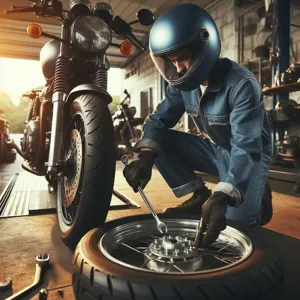For motorbike enthusiasts, the thrill of the open road is a cherished experience, but maintaining peak performance requires more than just a love for riding.
Just as an athlete must train and care for their body, your motorbike demands attention and regular maintenance to ensure it runs smoothly and safely. From the roar of the engine to the sleek handling on winding roads, every aspect of your bike depends on proper care and upkeep. In this blog post, we’ll explore essential maintenance tips that will not only enhance your motorbike’s performance but also extend its lifespan. Whether you’re a seasoned rider or a novice looking to elevate your skills, these practical insights will help you unlock the full potential of your machine, ensuring every ride is as exhilarating as the last. Join us as we delve into the world of motorbike maintenance and discover how to keep your two-wheeled companion in top shape for countless adventures ahead!
1. Introduction to Peak Performance in Motorbikes

When it comes to motorbikes, peak performance is not just a concept—it’s the exhilarating sensation of the wind rushing past you as you navigate winding roads, the thrill of acceleration as you conquer straightaways, and the pure joy of riding a machine that responds seamlessly to your every command. Achieving this level of performance requires more than just a powerful engine and sleek design; it demands a commitment to regular maintenance and an understanding of the vital components that keep your bike running smoothly.
Just like an athlete preparing for a competition, your motorbike needs consistent care and attention to reach its full potential. From the engine and transmission to the brakes and tires, each part plays a crucial role in ensuring that your ride is not only enjoyable but also safe. Neglecting these components can lead to decreased performance, compromised safety, and, ultimately, a less rewarding riding experience.
In this guide, we will delve into the essential maintenance tips that will help you unlock the peak performance of your motorbike. Whether you’re a seasoned rider or a newcomer to the world of two wheels, understanding these maintenance fundamentals will empower you to keep your bike in top-notch condition, allowing you to hit the road with confidence and enthusiasm. So, let’s gear up and explore the best practices for maintaining your motorbike, ensuring that every ride is as thrilling as the last!
2. Understanding the Importance of Regular Maintenance
When it comes to owning a motorbike, understanding the importance of regular maintenance is crucial for ensuring its longevity, performance, and your safety on the road. Just like your body requires regular check-ups to stay healthy, your bike benefits immensely from routine care and attention. Neglecting this fundamental aspect can lead to more severe issues down the line, potentially costing you not just money, but also risking your safety.
Regular maintenance encompasses a variety of tasks, from checking fluid levels and inspecting brakes to monitoring tire pressure and cleaning air filters. Each of these components plays a vital role in your bike’s overall performance. For instance, underinflated tires can significantly affect handling and fuel efficiency, while worn-out brake pads can compromise your stopping power, putting you in harm’s way.
Moreover, routine maintenance helps to identify minor issues before they escalate into major repairs. A simple oil change, for example, can keep your engine running smoothly, preventing wear and tear that could lead to costly engine repairs. By dedicating time to regular inspections and servicing, you not only enhance the bike’s performance but also improve your riding experience, allowing you to enjoy more of those exhilarating rides.
In essence, regular maintenance is not just about keeping your motorbike looking good; it’s about ensuring that it operates at its peak performance, keeps you safe, and prolongs its lifespan. Consider it an investment in your riding journey—one that pays dividends in reliability and enjoyment. So, make it a priority to incorporate maintenance into your routine, and you’ll reap the benefits every time you hit the open road.
3. Essential Tools Every Motorbike Owner Should Have

As a motorbike owner, having the right tools at your disposal is crucial for maintaining your ride and ensuring peak performance on the road. Whether you’re a seasoned mechanic or a casual enthusiast, equipping your garage with essential tools can make all the difference in keeping your motorbike in top shape. Here’s a rundown of the must-have tools every motorbike owner should consider:
**1. Socket Set:** A comprehensive socket set is foundational for any motorbike maintenance. Look for a set that includes a variety of sizes, both metric and imperial, to tackle different nuts and bolts on your bike. A ratchet and extension bar will also come in handy for those hard-to-reach areas.
**2. Torque Wrench:** Proper torque is vital for motorbike safety and performance. A torque wrench allows you to tighten bolts to the manufacturer’s specifications, preventing over-tightening or under-tightening, which can lead to mechanical failures.
**3. Screwdrivers:** A set of quality screwdrivers, including flathead and Phillips, is essential for various adjustments and repairs. Consider investing in a magnetic tip screwdriver for added convenience, as it helps keep screws in place when working in tight spots.
**4. Pliers and Wire Cutters:** These versatile tools are invaluable for gripping, twisting, and cutting wires or cables. Needle-nose pliers can be particularly useful for accessing tight areas, while wire cutters are perfect for managing electrical components.
**5. Tire Pressure Gauge:** Maintaining the correct tire pressure is critical for handling and safety. A reliable tire pressure gauge will help you monitor your tires regularly, ensuring they are always at the optimal level for your riding conditions.
**6. Chain Maintenance Tools:** For motorcycles with a chain drive, a chain cleaner and lubricant are essential. A chain tool can also help you adjust or replace links when needed, keeping your bike running smoothly.
**7. Cleaning Supplies:** Regular cleaning not only keeps your motorbike looking great but also helps prevent corrosion and wear. Invest in microfiber cloths, brushes, and a gentle motorcycle cleaner to maintain the finish and functionality of your bike.
**8. First Aid Kit:** Safety should always be a priority. A well-stocked first aid kit can be a lifesaver in case of minor injuries while working on your bike or during rides. This should include bandages, antiseptic wipes, and essential medications.
By keeping these essential tools at hand, you’ll be better equipped to handle routine maintenance and unexpected repairs, empowering you to enjoy your motorbike to its fullest. Regular upkeep will not only enhance performance but also extend the lifespan of your beloved ride, ensuring countless adventures ahead.
4. Checking and Changing the Oil: A Step-by-Step Guide
Maintaining the health of your motorbike is a critical aspect of ensuring it performs at its best, and one of the most vital tasks you can undertake is checking and changing the oil. Regular oil changes not only extend the life of your engine but also enhance its performance, ensuring that your rides are smooth and trouble-free. Here’s a comprehensive step-by-step guide to help you through the oil check and change process.
### Step 1: Gather Your Supplies
Before you dive into the task, gather all necessary tools and supplies. You’ll need a new oil filter, the correct type of oil for your bike (check your owner’s manual for specifications), a wrench to remove the oil drain plug, a funnel, an oil catch pan, and some rags for cleanup. Having everything at hand will make the process much smoother.
### Step 2: Warm Up the Engine
Start by warming up your engine for a few minutes. This is important because warm oil flows more easily, allowing for a more thorough drain. However, be cautious not to overheat the engine; just enough warmth to make the oil easier to work with is ideal.
### Step 3: Position Your Bike
Once warmed up, turn off the engine and position your bike on a level surface. Using a motorcycle stand can be helpful for stability and access. Place the oil catch pan under the oil drain plug to collect the old oil.
### Step 4: Drain the Old Oil
Using your wrench, carefully remove the oil drain plug. Allow the old oil to completely drain into the catch pan. This may take a few moments, so be patient. While the oil is draining, inspect the drain plug for any metal shavings or debris, which could indicate engine wear.
### Step 5: Replace the Oil Filter
With the old oil fully drained, it’s time to replace the oil filter. Use an oil filter wrench to remove the old filter, making sure to have a rag handy to catch any residual oil. Before installing the new filter, apply a small amount of new oil to the rubber gasket of the new filter; this helps create a good seal and makes it easier to remove during the next change. Screw the new filter into place, hand-tightening it securely.
### Step 6: Add New Oil
Reattach the drain plug securely, and then use your funnel to pour in the new oil through the oil filler cap. Refer to your owner’s manual for the correct oil capacity. Take your time, ensuring you don’t overfill, as this can lead to increased pressure and potential leaks.
### Step 7: Check Oil Level
After adding oil, give your bike a moment to settle. Remove the dipstick (if equipped) or check the sight glass to ensure the oil level is correct. Add more oil if necessary, ensuring it sits between the minimum and maximum marks.
### Step 8: Clean Up
Once everything is in place, clean up your workspace and dispose of the old oil and filter properly. Many auto parts stores and service centers will accept used oil for recycling, so check for local disposal options to ensure you’re being environmentally responsible.
### Step 9: Start the Engine
Finally, start your motorbike and let it run for a minute. This allows the new oil to circulate throughout the engine. Check for any leaks around the drain plug and oil filter. If everything looks good, you’re ready to hit the road!
By following these steps to check and change your motor
5. Keeping Your Tyres in Top Condition

Tyres are the unsung heroes of your motorbike, forming the critical connection between you and the road. Neglecting their maintenance can lead to reduced performance and safety hazards, making it essential to keep them in top condition. Regularly checking the tyre pressure is a fundamental yet often overlooked task. Under-inflated tyres can cause poor handling and increased fuel consumption, while over-inflation can lead to a harsher ride and uneven wear. Aim to check the pressure at least once a month and before any long ride, always adjusting it to the manufacturer’s recommended specifications.
Visual inspections are equally important. Look for any signs of wear and tear, such as cracks, bulges, or uneven tread patterns. These could indicate a potential blowout or compromised grip, especially in wet conditions. If you notice excessive wear on one side, it may be a sign of misalignment or improper suspension settings—issues that should be addressed immediately to ensure your safety and enhance your riding experience.
Don’t forget about tread depth, which is crucial for maintaining traction. In many regions, the legal minimum tread depth is 1.6mm, but for optimal performance, especially in wet weather, it’s advisable to replace tyres when they reach around 3mm. Investing in quality tyres designed for your riding style and conditions can make a significant difference in performance and safety.
Finally, consider the age of your tyres. Even if they appear to be in good condition, rubber compounds degrade over time. As a general rule, if your tyres are over five years old, it’s wise to have them professionally inspected, and if they’re over ten years old, it’s time to replace them—regardless of tread wear.
By keeping your tyres in top condition, you not only enhance your motorbike’s performance but also ensure a safer ride every time you hit the road. Regular maintenance of this essential component is not just an option; it’s a necessity for any responsible rider.
6. Brake System Maintenance: Ensuring Safety and Performance
The brake system of your motorbike is not just a critical component for safety; it’s also integral to the overall performance of your ride. Ignoring brake maintenance can lead to diminished stopping power, increased wear on components, and potentially dangerous situations on the road. Thus, prioritizing brake system maintenance is an essential part of unlocking your bike’s peak performance.
Start with a visual inspection of the brake pads. Look for signs of wear—if they appear thin or uneven, it’s time for a replacement. Worn brake pads can greatly reduce your bike’s ability to stop quickly, especially in emergency situations. Additionally, don’t forget to check the brake discs for any scoring or warping, which can compromise braking efficiency. Smooth, well-maintained discs are crucial for optimal performance.
Next, pay attention to the brake fluid. Over time, brake fluid can absorb moisture, leading to reduced effectiveness and potentially causing components to rust. Regularly check the fluid level and color; if it appears dark or murky, a fluid change may be necessary. Always use the manufacturer-recommended fluid type to ensure compatibility and optimal performance.
Another essential aspect of brake system maintenance is inspecting the brake lines. Look for any signs of fraying, cracks, or leaks. Damaged brake lines can lead to catastrophic brake failure, so it’s vital to address any issues immediately. If your bike has hydraulic brakes, ensure that the master cylinder is functioning properly and that the fluid reservoir is filled to the appropriate level.
Lastly, remember that brake system maintenance isn’t just about function; it’s about safety. Regularly scheduled checks, ideally before every ride or at least once a month, will help you catch any potential issues before they become serious problems. Keeping your brake system in top condition not only boosts your bike’s performance, but it also ensures a safer ride, allowing you to enjoy the thrill of the open road with peace of mind. By taking these proactive steps, you’re not just maintaining your motorbike; you’re enhancing your entire riding experience.
7. Cleaning and Lubricating the Chain

Cleaning and lubricating the chain is one of the most crucial maintenance tasks for any motorbike enthusiast looking to unlock peak performance. The chain is not just a component; it is the lifeline of your bike’s power delivery system, transferring engine energy to the rear wheel. A clean and well-lubricated chain ensures smooth operation, enhances longevity, and optimizes performance, making it essential for both safety and efficiency.
Start by raising the bike securely on a stand, which allows easy access to the chain. Using a soft brush or cloth, gently scrub away dirt, grime, and any stubborn residue that may have accumulated. Pay close attention to the side plates and rollers, as these areas often trap debris. A specialized chain cleaner can be highly effective in breaking down grease and contaminants, providing your chain with a fresh start.
Once the chain is clean, it’s time to lubricate. Choose a high-quality motorcycle chain lubricant that is suitable for your riding conditions—whether you’re navigating city streets or tearing through muddy trails. Apply the lubricant evenly along the entire length of the chain while rotating the wheel to ensure complete coverage. This step is vital, as it not only facilitates smooth engagement but also protects against rust and wear.
Remember to wipe off any excess lubricant after application. Over-lubricating can attract dirt and dust, leading to premature wear. Ideally, you should clean and lubricate your chain every 500 to 1,000 kilometers, or more frequently if you ride in harsh conditions.
Incorporating this simple yet effective maintenance routine into your bike care regimen will not only extend the life of your chain but also result in a smoother, more responsive ride. With a well-maintained chain, you’ll experience improved acceleration, reduced friction, and the peace of mind that comes with knowing you’re keeping your motorbike in peak condition.
8. Battery Care: Tips for Longevity and Reliability
When it comes to motorbike maintenance, one component that often gets overlooked is the battery. Yet, it plays a crucial role in ensuring your bike starts smoothly and runs efficiently. Proper battery care not only enhances reliability but also extends its lifespan, saving you time and money in the long run. Here are some essential tips to keep your battery in peak condition.
First and foremost, regularly check the battery terminals for any signs of corrosion. A buildup of grime can impede electrical flow, leading to starting issues. Cleaning the terminals with a mixture of baking soda and water can help neutralize any corrosion, ensuring a solid connection. Make sure to disconnect the cables before cleaning, and reconnect them firmly afterwards to prevent any loose connections.
Next, monitor the battery’s fluid levels if you have a conventional lead-acid battery. These batteries rely on a liquid electrolyte to function effectively. If the fluid is low, top it up with distilled water to maintain the proper level, which is typically just above the lead plates. Avoid using tap water, as it contains impurities that can harm the battery’s performance.
Temperature extremes can also affect battery life. If you live in a region with harsh winters or scorching summers, consider investing in a battery maintainer or tender. These devices help keep the battery charged and ready to go, especially during periods of inactivity, which are common in off-seasons.
Lastly, don’t forget about regular inspections. Check for signs of wear and tear, such as cracks or swelling in the battery case, which can indicate a failing unit. If your battery is more than three to five years old, it may be time to consider a replacement.
By following these simple yet effective battery care tips, you can ensure your motorbike remains reliable and ready for the open road, providing you with the performance you need for all your adventures. Remember, a well-maintained battery is the heartbeat of your bike, so give it the attention it deserves!
9. Inspecting and Replacing Air Filters
When it comes to ensuring your motorbike operates at peak performance, one of the most often overlooked components is the air filter. An efficient air filter plays a crucial role in your bike’s overall health, as it ensures that your engine receives a clean supply of air for optimal combustion. Over time, dust, debris, and other contaminants can clog the filter, leading to reduced airflow, decreased fuel efficiency, and even potential engine damage.
Start by regularly inspecting your air filter. If you ride in dusty conditions or frequently encounter off-road terrain, consider checking it more often—ideally every couple of weeks. Look for signs of dirt buildup or visible damage. A clean filter should appear light and free of obstruction, while a clogged one may look discolored and feel heavy.
When it’s time for a replacement, choose a high-quality air filter that suits your bike’s model and riding style. While reusable filters can be more cost-effective in the long run, disposable options can offer convenience. Ensure you consult your owner’s manual for specific recommendations regarding maintenance schedules and types of filters.
When installing a new filter, take care to fit it securely in place, as a poor seal can allow unfiltered air to enter the engine, leading to performance issues. A correctly maintained air filter will not only help your bike run smoothly but also improve throttle response and overall acceleration.
By incorporating regular air filter inspections and timely replacements into your maintenance routine, you can enhance your motorbike’s efficiency and longevity, allowing you to ride with confidence, knowing your machine is in its best shape. Remember, a well-breathing engine is a happy engine!
10. The Importance of Regular Fluid Checks
When it comes to maximizing the performance and longevity of your motorbike, regular fluid checks should be at the top of your maintenance to-do list. Just like a human body needs water and nutrients to function optimally, your bike relies on a range of fluids—engine oil, coolant, brake fluid, and transmission fluid—to operate smoothly.
Engine oil is the lifeblood of your motorcycle, ensuring that all moving parts work in harmony. Over time, oil can become contaminated with dirt and debris, losing its lubricating properties and potentially leading to engine wear or even catastrophic failure. Checking the oil level regularly and changing it according to your manufacturer’s recommendations can prevent costly repairs and keep your engine humming like new.
Coolant, on the other hand, is essential for regulating your bike’s temperature. An overheating engine can lead to severe damage, so ensure that your coolant levels are adequate and the fluid is free of contaminants. Don’t forget to inspect the hoses and clamps for any signs of wear or leaks, as these can compromise your cooling system’s efficiency.
Brake fluid is another critical component that often gets overlooked. Proper brake function is vital for your safety, and degraded brake fluid can significantly diminish your stopping power. Regularly checking and replacing brake fluid as needed is crucial, especially before embarking on longer rides or after periods of inactivity.
Lastly, transmission fluid plays a key role in ensuring smooth gear shifts and overall bike performance. Keeping an eye on its level and condition can help you catch potential issues before they escalate.
Incorporating regular fluid checks into your maintenance routine not only enhances safety but also elevates your riding experience. By committing to this essential habit, you’ll ensure your motorbike performs at its peak, allowing you to enjoy the open road with confidence and peace of mind.
11. Monitoring Electrical Systems and Lights
Monitoring the electrical systems and lights of your motorbike is crucial to ensuring both safety and performance on the road. The electrical system is the heart of your bike, powering everything from the ignition to the headlights, and any failure can lead to serious consequences. Regular checks can prevent small issues from becoming major headaches.
Start by inspecting the battery. Look for any signs of corrosion around the terminals, which can impede performance. Clean the terminals with a solution of baking soda and water if you spot any buildup. Also, check the battery’s charge level, especially before long rides or after periods of inactivity. A well-maintained battery is essential for reliable starts and smooth operation.
Next, turn your attention to the wiring. Inspect the wires for frays, cracks, or any signs of wear. Pay close attention to areas where wires are exposed to abrasion or extreme temperatures, as these can lead to electrical shorts. Secure any loose connections and replace damaged wires promptly to avoid potential failures.
The lights on your motorbike not only illuminate your path but also communicate your presence to other road users. Regularly check that all lights—headlights, brake lights, turn signals, and indicators—are functioning correctly. A burned-out bulb can lead to dangerous situations or traffic violations. If you notice a dim light or flickering, it may indicate an underlying electrical issue, so don’t hesitate to investigate further.
Finally, consider integrating a routine check into your maintenance schedule. Dedicate a few minutes each month to test your bike’s electrical systems and lights. This practice not only enhances your safety but also prolongs the lifespan of your bike’s electrical components, ensuring that your ride remains enjoyable and dependable. By keeping a close eye on these vital systems, you’re taking a proactive step towards unlocking the peak performance of your motorbike.
12. Seasonal Maintenance: Preparing Your Bike for Different Weather
As the seasons change, so do the demands placed on your motorbike. Each weather condition presents unique challenges that can affect performance and safety. Therefore, seasonal maintenance is not just a good practice; it’s essential for unlocking peak performance year-round.
**Spring Preparation**: After a long winter, your motorbike deserves some tender loving care. Start by thoroughly cleaning the bike to remove any salt or grime that accumulated during snowy months. Check the battery, as cold weather can drain it. Inspect the tires for wear and ensure proper inflation, as temperature fluctuations can affect tire pressure. Finally, give the brakes a once-over to ensure they are functioning at peak efficiency before hitting the open road.
**Summer Savvy**: High temperatures can lead to overheating and increased wear on your engine. Ensure your coolant levels are topped up and inspect hoses for any signs of wear or leaks. Additionally, make it a habit to check your oil more frequently during the hotter months, as it can break down faster in the heat. Remember to pay attention to your tires, too; hot asphalt can increase tire pressure, so adjust accordingly to maintain optimal performance.
**Autumn Adjustments**: As the leaves begin to fall, riding conditions can become trickier with wet roads and reduced visibility. It’s crucial to check your lights and signals to ensure they are functioning properly. Also, consider switching to a more aggressive tread pattern on your tires for better grip on slick surfaces. Don’t forget to clean your bike thoroughly, as road debris and leaves can accumulate and cause damage if left unattended.
**Winterizing Your Bike**: If you live in an area where winter means snow and ice, proper winterization of your motorbike is vital. Start by changing the oil and adding a fuel stabilizer to prevent gumming in the engine. It’s also wise to remove the battery and store it in a warm place to keep it charged and healthy. Finally, cover your bike with a breathable motorcycle cover to protect it from the elements while it waits for warmer days.
By tailoring your maintenance routine to the seasonal demands, you can ensure your motorbike remains in top condition, ready to deliver peak performance no matter the weather. This proactive approach not only extends the lifespan of your bike but also enhances your riding experience, making each journey as enjoyable as the last.
13. Tips for Storing Your Motorbike Properly
Proper storage of your motorbike is crucial for maintaining its peak performance and longevity, especially when it’s not in use for an extended period. Whether you’re preparing for the off-season or simply need to tuck your bike away for a few weeks, following some essential storage tips can help safeguard your investment and keep it in top shape.
First, choose a suitable location for storage. Aim for a cool, dry place that is shielded from direct sunlight, extreme temperatures, and moisture. A garage or a dedicated shed works best, but if those aren’t available, consider investing in a high-quality bike cover that protects against the elements. This cover should be breathable to prevent moisture buildup, which can lead to rust and corrosion.
Before storing your motorbike, perform a thorough cleaning. Wash away dirt, grime, and road salt, paying special attention to the chain and undercarriage. After cleaning, apply a layer of wax to the bodywork to protect the paint. It’s also advisable to lubricate moving parts, such as the chain and cables, to keep them functioning smoothly when you bring the bike back out.
Next, consider the fuel system. It’s wise to fill your tank to prevent moisture buildup inside, and adding a fuel stabilizer can keep the fuel from degrading. Run the engine for a few minutes to ensure the stabilizer circulates throughout the system. Additionally, disconnect the battery or use a battery maintainer to keep it charged during long storage periods.
Tires also need attention. Check the tire pressure and inflate them to the recommended levels to prevent flat spots. If possible, elevate your bike using stands to relieve pressure on the tires and suspension.
Lastly, don’t forget to cover any exposed parts, such as the seat and mirrors, with cloths or specialized covers to minimize dust accumulation. By following these storage tips, you’ll ensure that your motorbike is ready to hit the road whenever you are, performing at its best and looking like new.
14. When to Seek Professional Help
While many motorbike enthusiasts relish the hands-on approach of maintenance, there comes a time when the expertise of a professional becomes indispensable. Understanding when to seek professional help is crucial for ensuring both your safety and the longevity of your bike.
If you notice unusual sounds emanating from the engine, such as knocking or grinding, it’s a clear signal that something isn’t right. Strange vibrations can indicate alignment issues or problems with the suspension, which require a trained eye to diagnose and fix. Additionally, if your bike is leaking fluids—be it oil, coolant, or brake fluid—it’s a sign that you should not delay in consulting a mechanic. These leaks can lead to serious issues if left unaddressed, compromising both performance and safety.
Another critical moment to consider professional intervention is during routine maintenance checks, especially if you’re unfamiliar with the intricate systems of your motorbike. Tasks such as brake pad replacement, tire alignment, and chain adjustments may seem straightforward, but improper handling can lead to dangerous situations on the road.
Moreover, if your bike’s performance suddenly decreases, such as sluggish acceleration or difficulty starting, it’s wise to consult a professional. These symptoms could be indicative of deeper issues like fuel system problems or electrical faults, which require specialized knowledge and tools to resolve.
In summary, while DIY maintenance can be fulfilling and cost-effective, recognizing when to hand over the reins to a professional is equally important. Trusting a skilled mechanic not only preserves the integrity of your bike but also enhances your riding experience, allowing you to enjoy the open road with confidence.
15. Conclusion: Keeping Your Motorbike at Peak Performance
In conclusion, maintaining your motorbike at peak performance isn’t just about ensuring it runs smoothly; it’s about fostering a deeper connection between you and your ride. By regularly performing essential maintenance tasks—such as checking tire pressure, changing the oil, inspecting the brakes, and cleaning the air filter—you can extend the life of your bike while enhancing your overall riding experience.
Remember, a well-maintained motorbike not only performs better but also offers you peace of mind on the road. The thrill of riding is amplified when you know your machine is in top condition, ready to respond to your every command. Regular maintenance is a small investment of time and resources that pays off in reliability and enjoyment.
Take the time to understand your motorbike’s specific needs and follow a maintenance schedule that works for you. Whether you’re a seasoned rider or a newcomer, these simple tips will empower you to unlock the full potential of your machine. So, gear up and hit the road with confidence, knowing that you’ve done your part to keep your motorbike in peak performance. Happy riding!
In conclusion, maintaining your motorbike is not just about keeping it in good shape; it’s about unlocking its full potential and ensuring you enjoy every ride to the max. By following the essential maintenance tips outlined in this blog post, you can enhance performance, increase longevity, and ensure your safety on the road. From regular oil changes to keeping your tires in prime condition, each step you take contributes to a smoother, more exhilarating riding experience. So, gear up, embrace the journey, and let your well-maintained motorbike take you to new adventures. Here’s to countless miles of joy and the thrill of the open road! 🏍️✨






